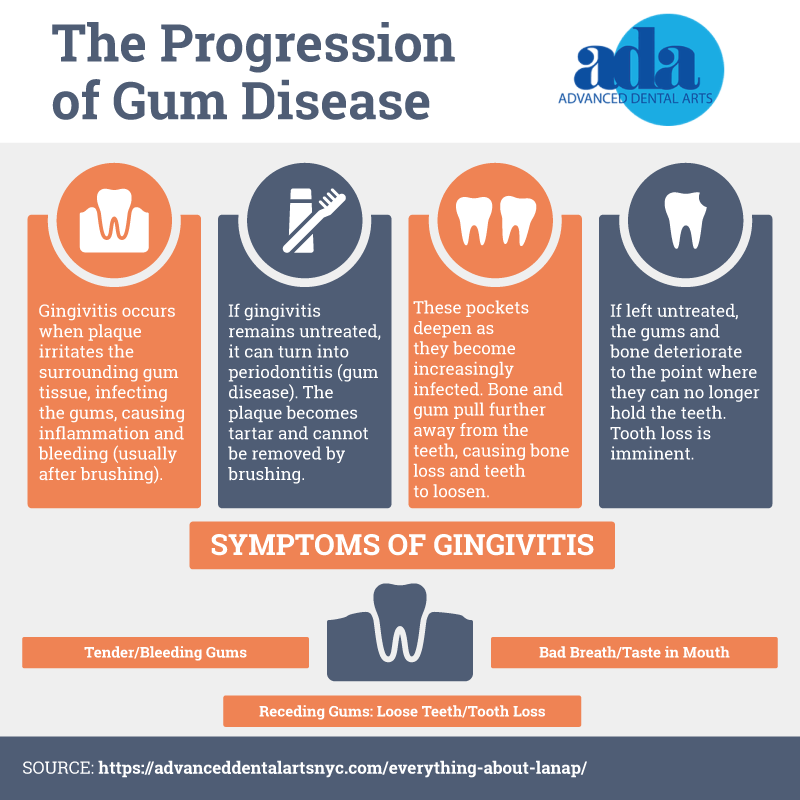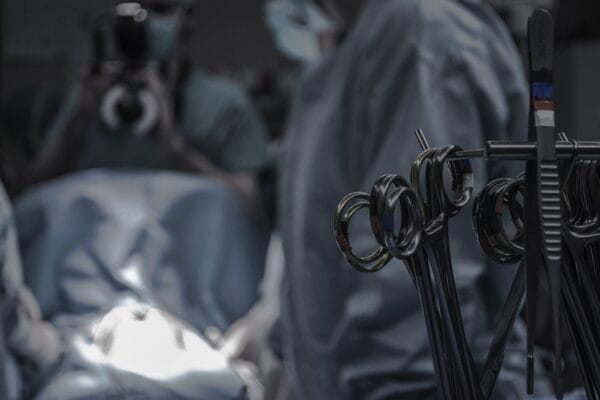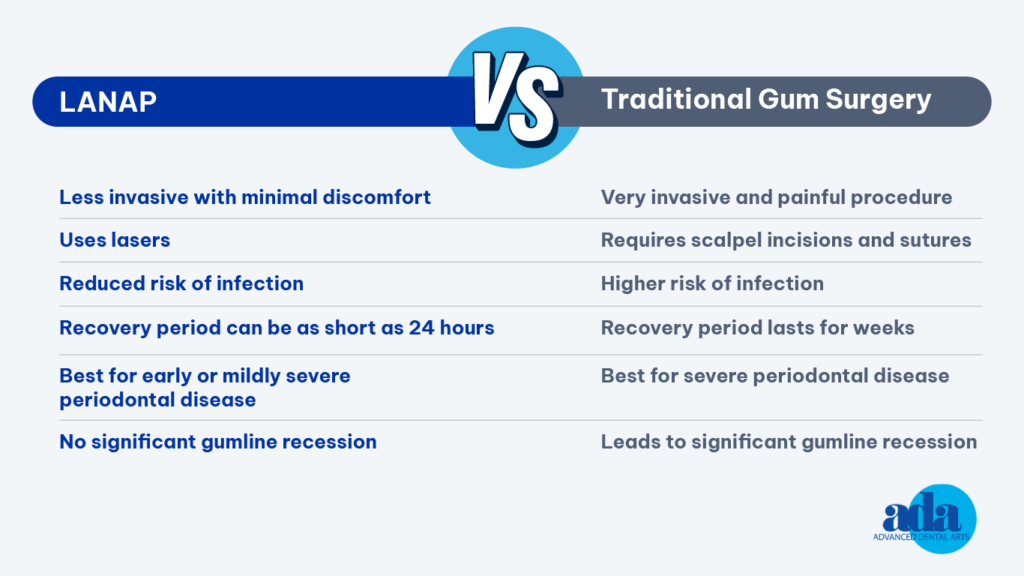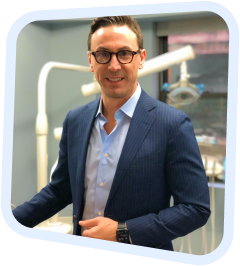The Noninvasive Way to Treat Periodontal (Gum) Disease
It’s understandable to be worried at first if you’ve been diagnosed with advanced periodontitis, also known as gum disease. Gum disease can lead to many unpleasant symptoms that can leave you feeling self-conscious and worried about the future. Not only for your smile, but also your overall health. Luckily, there’s a quick and easy cure for gum disease known as the Laser-Assisted New Attachment Procedure (LANAP®).
With LANAP®, you can visit your dentist or periodontist, receive treatment, and get back to your life with virtually no interruption to your daily routine. But before you agree to the procedure, you need to fully understand what gum disease is, how it progresses, and what all your treatment options are. Having a sound foundation of knowledge will help you make the best, most informed decision to support both your oral and overall health.

What Is Gum Disease?
Most people are familiar with gingivitis, an inflammation of the gums, as the earliest stage of gum disease. This condition often occurs due to a lack of proper oral hygiene, but can also be caused by:
- Hormonal Changes
- Illness
- Medication
- Smoking
- Genetics
- Sleep Apnea
Still, the most common cause tends to be poor oral hygiene. When patients fail to brush, floss, and visit their local dentists for professional cleanings, plaque builds up on their teeth. Over time, this plaque irritates the surrounding tissue, causing the gums to become inflamed and bleed slightly.
If gingivitis remains untreated, it can turn into periodontitis (gum disease). In this early stage of gum disease, the plaque turns into tartar, a substance that cannot be removed by brushing. The tartar essentially forms a colony of bacteria that continues to irritate the surrounding tissue and bone. As a result, gums pull further away from the teeth, creating spaces called “pockets”.
These pockets deepen as they grow more and more infected. Bone and gum pull further away from the teeth, causing bone loss and teeth to loosen. As the body tries to fight off the infection, enzymes break down the gum tissue and even attack the surrounding bone itself. If left untreated, the gums and bone deteriorate to the point where they can no longer hold the teeth. These loose teeth fall out.
While gingivitis can be treated on its own with rigorous oral hygiene, periodontitis requires the help of a dental professional to cure.
What Are the Symptoms of Gum Disease?

Periodontitis can be a very sneaky disease. While there are clear signs of the disease’s progression, symptoms can be subtle and even painless. These are the clear warning signs that you may have gum disease:
- Bad Breath: the bacteria on the plaque and tartar produce foul-smelling odors.
- Bad Taste: the infection can produce unpleasant tastes in the patient’s mouth.
- Tender gums: infection causes inflammation that irritates the gum tissue, leaving them sensitive.
- Bleeding Gums: plaque and tartar inflame and irritate the surrounding gums, brushing and flossing further irritates the sensitive issue causing bleeding.
- Receding Gums: As pockets form, gums pull away from the teeth.
- Loose Teeth: The more advanced the pockets are, the less tissue and bone surrounds the tooth, anchoring them in. This causes them to shift around and potentially fall out.
Treatments for Gum Disease
Because gum disease is often subtle, it’s always important to both practice proper oral hygiene and visit your dentist for regular check-ups. However, if your dentist discovers gum disease, they will perform certain treatments depending on how severe your gum disease is.
During your dental visit, your dentist will examine your gums, looking for signs of inflammation and infection. If you’re in the early stages of gum disease, then your dentist will most likely perform a teeth cleaning. Then they’ll review proper oral hygiene while discussing possible lifestyle changes (quitting smoking, for instance) to prevent the advancement of gingivitis into gum disease.

If there are signs of gum disease, your dentist will use a probe to determine how large the pockets are. Early stages of gum disease involve the use of scaling and debridement. During this procedure, your healthcare professional will clean the tooth above and below the gum line using an ultrasonic tool that breaks up the tartar.
In earlier stages of gum disease, your healthcare professional may also prescribe a medicated mouthwash and/or antibiotics to treat the infection. There are many other treatments for early-stage gum disease as well. You may receive antibiotic microspheres, antibiotic gels, enzyme suppressants, or antiseptic chips to help destroy the harmful bacteria.
However, if your gum disease has advanced to later stages, more invasive procedures are necessary to restore your gums to their natural, healthy condition.
What Is the Traditional Treatment for Gum Disease?
Traditional treatment for gum disease involves surgery. During this invasive procedure, your periodontist will use a scalpel to cut and flap back the diseased gum so they can scrape the bone underneath to remove the infection. They’ll then add some bone material to refill the areas that have experienced bone loss from the disease, and use sutures (stitches) to connect the gums back to the teeth. The gums heal closer to the teeth and healthy gum tissue grows, helping restore the gums to a natural look and feel over time.

The Significant Downsides to Traditional Periodontal Surgery:
- It’s painful. Despite anesthetic, the use of a scalpel to remove tissue means recovery will be painful. Your periodontist may prescribe medications to help you manage the pain, but even then, there is still a level of discomfort.
- It’s difficult. You will be limited in what you can eat as well as how you can clean your mouth afterward. Both the sutures and tissues are sensitive, and you’ll need to be careful not to damage the area after surgery.
- It’s long. It takes a few days for the pain to fade and weeks to recover fully. You may also need to return to your periodontist to have your sutures removed (if they do not dissolve on their own in a timely manner).
- The gums shrink away permanently.
- This Surgery most typically is done every 2-3 years.
Traditional gum surgery is often done on only one part of the mouth at a time to help minimize discomfort and allow other areas of the mouth to be used for chewing. Still, many patients don’t return for the remaining procedures due to how painful and troublesome it is.
This is where LANAP® offers a far superior solution.
Traditional gum surgery is a thing of the past. With Laser-assisted new attachment procedure (LANAP®), your periodontist will use a laser to target and remove diseased tissue. This means that you WON’T need to worry about scalpels(and sutures) and painfully removing gum tissue. Instead, LANAP® provides a far less invasive procedure with faster recovery times.
So much better, in fact, you’ll wonder why traditional gum surgery still exists…
An Overview of the LANAP® Procedure
Your healthcare professional will:
- Probe your gums to determine the level of treatment needed for each tooth
- Use a laser that basically targets the bad, infection-causing bacteria
- Use ultrasonic scalers and other instruments to remove disease-causing tartar
- Use the laser again to connect gum tissue back to the root
- Adjust tooth surfaces to further prevent the formation of new tartar (occlusal adjustment).
How Long Does LANAP® Take?
The procedure takes roughly an hour to two hours, depending on the extent of the gum disease. Depending on the extent of gum disease, you can complete the procedure in either one or two visits.
How Long Does It Take to Recover from LANAP®?
Afterward, the patient can go about their day normally with minimal discomfort. There are no sutures to worry about and no lasting discomfort. In fact, recovery time is around 24 hours, much faster than the 2 – 4 weeks traditional gum surgery takes.
Myths About LANAP®
There are several myths about LANAP® that may lead you to worry about the effectiveness of the treatment. Here they are so you can avoid them.
Myth #1: Any Dentist Can Perform the LANAP® Procedure
Only trained, qualified periodontists and dentists can use LANAP® lasers on patients. They undergo a year-long, intensive training process that happens at the Institute for Advanced Laser Dentistry. Dentists train other dentists on the procedure with plenty of oversight and rigorous standards. At the end of the training, they receive a LANAP® proficiency certificate.
Myth #2: LANAP® Is Expensive
LANAP® costs roughly the same as traditional gum surgery.
Myth #3: Any Laser Can Be Used for LANAP®
Different lasers do different things. LANAP® uses a very specific laser, the PerioLase MVP-7, to treat gum disease. This laser only targets the diseased gums, destroying the bad bacteria while preserving healthy tissue. No other laser can be used for this procedure.
Myth #4: LANAP® is Dangerous
LANAP® uses an FDA-approved, safe laser that only interacts with harmful bacteria. There’s no risk of radiation or interaction with other medications as well. You may have to take x-rays before the procedure, but the risk is minimal there as well. Keep in mind that there are inherent risks in any medical procedure. Your healthcare professional will discuss those with you before beginning the surgery so that you’re fully informed.
Myth #5: LANAP® Is Less Effective Than Traditional Treatment
Some patients worry that LANAP® is less effective than traditional options or that they may be more likely to need additional treatment if they choose laser treatment. Fortunately, these worries are unjustified.
In addition to the many short-term ways LANAP® outperforms traditional surgical options, there are many favorable long-term benefits to choosing laser treatment. Compared to traditional surgery, LANAP® has excellent patient outcomes in tooth stability and retreatment rates.
What Are the Benefits of LANAP®
To recap, there are numerous benefits that LANAP® has over traditional gum surgery. There’s less bleeding because no scalpels or sutures are used. As a result, there’s less pain and less sensitivity to your teeth. Plus, there’s a lower risk of infection after the operation. Swelling and gum loss are also minimal.
With LANAP®, you’ll be able to return to your normal life much faster, and your gums will not only heal on their own, but you will also naturally regenerate the bone around your teeth that hold them in place.
Are There Any Downsides to LANAP®?
The only downside to LANAP® is that the treatment may not be right for you if your periodontal disease is too advanced. In those cases, you’ll have to undergo alternative procedures that may include removal and replacement of the teeth. This is why you should speak to your dentist right away if you suspect you may have gum disease.
What Happens if You Ignore Gum Disease?
While it may seem like periodontitis only creates cosmetic issues and can be ignored, that’s far from the case. Untreated periodontitis can lead to tooth loss and even serious health conditions. As gum disease advances, bacteria can break off into the bloodstream and start affecting your organs. This can worsen conditions like kidney and heart disease.
It’s also important to note that periodontitis can hint at other serious health conditions as well. It’s important to talk to your doctor about your gum disease and what that means for your overall health.
Is LANAP® Right for Me?
Most patients suffering from gum disease can benefit from LANAP®. Because LANAP® uses a laser instead of traditional cutting instruments, even patients that may not qualify for traditional gum surgery (such as those taking blood thinners) can benefit from LANAP®.
Though most cases qualify for LANAP®, certain circumstances may affect your treatment options. For example, patients in the late stages of gum disease may require additional work or more than one session to restore lost bone tissue.
The only way to know for sure if you qualify for LANAP® treatment is to make an appointment and review your options with a periodontist.
LANAP® offers a simple solution that can naturally restore your gum health providing your gum disease isn’t too far advanced. There are virtually no downsides, and a quick recovery means that you can get back to a healthier, better life quickly.
There’s no need to suffer through traditional gum surgery. Find a qualified LANAP®-trained periodontist and discuss possible treatment as soon as you can.

How Can I Find a LANAP®-Trained Periodontist?
You don’t want to wait around with gum disease. It will only progress without professional treatment. Luckily, there are plenty of periodontists and trained dentists who know how revolutionary this technology is. Many of them already have plenty of experience helping restore patients’ gums. Simply search for local periodontists in your area and arrange an appointment.
If you’re looking for a LANAP®-trained doctor in New York City, then you should check out Advanced Dental Arts. We’re a top-rated dental practice in Manhattan with a team of board-certified dental health specialists ready to help you achieve that perfect healthy smile you’ve always wanted. We have trained, experienced LANAP®-certified staff members ready to treat your gum disease.
From general dentistry to LANAP®, you’ll find all of your dental treatments under one roof at Advanced Dental Arts. Don’t wait any longer. Your perfect smile is one phone call away.







